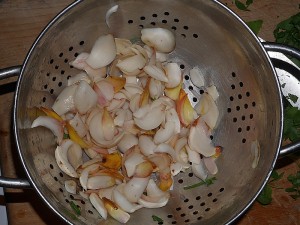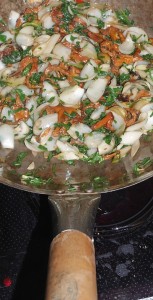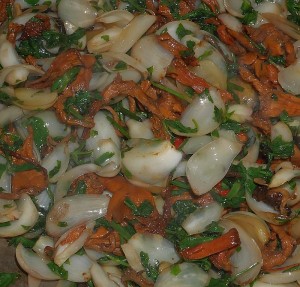A hundred embraces? Well, in Mandarin, lily bulbs are Bai He (百合), meaning “a hundred embraces”, because of the many scales hugging each other! In fact, one of the largest Chinese dating sites is baihe.com…
Lily bulbs are available in both fresh and dried forms. I told the story of how I bought fresh lily bulbs in a Singapore supermarket in 2003, how it overwintered in my garden and was identified as the beautiful Lilium davidii var willmottiae (pictures here:
http://www.edimentals.com/blog/?page_id=2207)
Autumn is the best time to harvest the bulbs and this I did last week (http://www.edimentals.com/blog/?page_id=2614)
On one web site, we’re told that the best-tasting ones are called Lanzhou Lily (兰州百合), with white and plump scales, as they are grown in the mountains around the city of Lanzhou in Gansu Province. They are also exported to Chinese markets around the world. Googling pictures of the Chinese name and pictures that look like Lilium davidii come up – the bulbs of this lily are also white and compact (see the link above!)
Tonight I made this stir fry:
Ingredients (see the picture for amounts used)
4 lily bulbs
A bunch of Fool’s watercress (Apium nodiflorum – a celery species; see my book Around the World in 80 plants for more)
Dried Winter chantarelle and chantarelles, soaked in warm water
Soya sauce
3 cloves of garlic
1 chili
Oil to fry
Salt and pepper
- Break up the bulbs into scales.
- Cut up the Fool’s watercress
- Blanch the bulbs and greens in salted boiling water for 10 seconds, and then rinse in cold water and drain.
- Heat the oil in a wok. Stir-fry the mushrooms for 3 minutes. Add the lily bulb scales, greens, chili, garlic, a little soy sauce and vinegar. Stir fry for a few minutes, add salt and pepper. Serve over organic buckwheat noodles.
WOW!! Superb….the lily scales are crunchy and a little sweet, no wonder this is gourmet food in the Far East!





